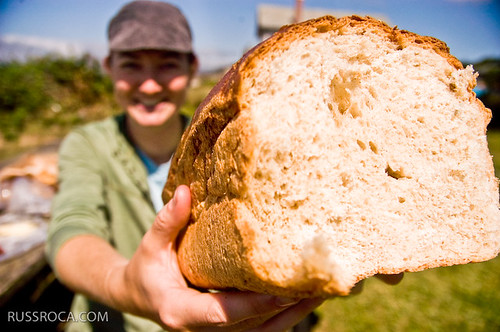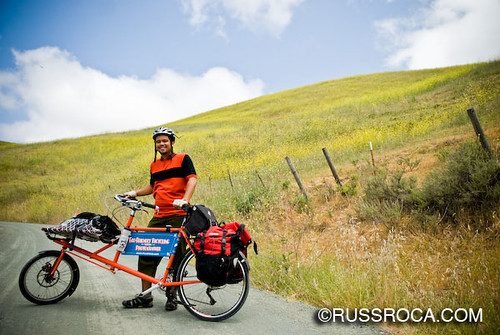Non-racers go further still, and in fact some cyclists are genuine foodies. There is now an emerging sub-genre of cycling food bloggers. They include Sam the Cycling Cook from Leicestershire and the Epicurean Cyclist who guides us on the delights of Belgium waffles on tour in Southern California.
One of the questions that the reporter asked (who happens to be a big fan of Rivendell, btw!), was when did cycling food change from "real food" to squishy goo. While I think its impossible to give an exact date and time, I think it has a lot to do with marketing. Just as people think the latest carbon-fiber-electronic-shifting-bicycle-shaped-object will make them go faster, the same assumptions are made about space-age goo dispensed from foil packets.

Simply put, they're spending the advertising dollars so they got a lot of press. Like Laura pointed out to me when we were talking about it, there's probably not a giant apple lobby pushing the agenda of Big Apple in Bicycling magazine. Aside from the marketing, I think there's also just the basic human desire to believe that performance or happiness is a shiny packaged object away.

Now, to be fair, there are instances when goo is indeed good. While eating a roasted chicken from your handlebar bag during a triathlon is more satisfying, it probably isn't very practical. Goo has a home in competitive cycling and sports. However, the causal rider that is pedaling at a comfy 12mph for a days ride, probably doesn't need to suck down XtremeUltraPowerMegaGel like their life depended on it. Horses for courses.
For the kind of riding I'm interested in, the goo can stay at home. I much prefer real food, especially foods from little cafes, or the local farmers market, or that are regional specialties. Or if I'm going to pack food with me, I'll go to the local grocer and get some cured meats and hard cheese for the road, something which I prefer over gels.
Some of my greatest memories of being on tour are inextricably tied to food. Having a cone of Bubblegum flavored Tillamook ice-cream for breakfast in Oregon, eating nearly a pound of fresh oysters and salmon at camp in Reedsport, drinking fresh brews at Pizza Port on the Southern California coast, eating arguably some of the best Belgian Waffles of my life at the Filling Station in Orange, having the thickest juiciest slices of bacon at Hoover's Beef Palace during the Great Western Bike Rally in Paso...the list goes on.
Dang. Now I'm hungry.

9 comments:
"Dang. Now I'm hungry."
Dang, me too. I think I need to bike over to the Snohomish Bakery for one of their awesome BLTs.
In terms of "when did cycling food change from "real food" to squishy goo" I think you hit nail on the head when you said that, "while eating a roasted chicken from your handlebar bag during a triathlon is more satisfying, it probably isn't very practical." I think if mostly about convenience. We have become a culture of convenience which is also expressed in every other part of our lives and not just when we're working out (though much more then). We have less and less time so we buy more and more quick and easy foods. Meanwhile the quality of food has suffered the consequences.
One might be able to look at other countries where bike cultures exists, Europe and Asia as an example, and see fewer instances of gooey foods.
Marketers in this culture have just been keen to pickup and and push what not only comes easy to us but easy for them as well.
2dp...I was thinking about that too...
Maybe the real start of the lineage of convenient sport food was with the advent of the TV dinner?
"...the lineage of convenient sport food was with the advent of the TV dinner"
The TV dinner is at least the poster child for convenience food. I seem to remember a while back seeing a documentary on food in an era of advertisement.
War time technology and a new sense possibilities and consequent affluence of post WWII America might be where it all began. Just like nylon and Velcro, food technology was really an invention of military necessity for rationing, storage, and ease of use by the troops while in combat, "who cares what it looked like" as long as it fed and kept the troops healthy.
Until WWII women mostly stayed at home and took care of the family needs so spent more time in the kitchen but during the war women were needed in the factories to fill the need while the men were at war.
After the war manufactures saw a way to use the available technology and so marketed "cheap and easy" to the public and hence Betty Crocker and Swanson might deserve some of the credit for making it easier for the now working mother to whip up dinner.
Sixty years on we have less and less time for cooking meanwhile food companies have automated food production making it even easier and cheaper which seem not be able to support aesthetics. I remember after we landed on the moon, everyone was talking about food becoming obsolete, we would only have to take a pill to get all our nutritional needs. Thankfully the idea that we would buy a handful of food pills at a vending machine seems to have been dismissed but then again much of food has lost it's nutrition that we now require supplements to ensure we get what we need.
As Napoleon said 'an army marches on its stomach' and it was indeed the French, the self anointed guardians of gastronomy that gave the world the tin can, or canister developed so Boney's army could march further on tinned supplies.
I know I'm not alone in starting to cycle so that I can justify a slice of pie à la mode. Bicyclists become foodies, foodies become cyclists, however it happens it's always good.
The past few Saturdays I rode 122 and 137 miles, and I didn't use any goo or mixed drink powder. I also didn't buy any food out either. I'm a fan of packing cheap and nutritious food, although I do use a few Clif bars for the dense carbs, mostly since I am a type 1 diabetic.
A typical day of food for me on a 100+ mile ride is:
Small bowl of cereal before I leave, apple, pear, 2 big celery sticks, granola, peanuts, wheat crackers, 2 Clif bars, 2 candy bars, and some jerky.
I'm a skinny guy, and especially on long days of riding I like a healthy mix of fruits and fats, and just enough carbs to keep my sugar from going too low. My waterbottles contain grape/peach juice, and G2 (the low sugar Gatorade).
This is a great post with great conversation and quite timely. I have been a big proponent of Hammer Nutrition products from many years now. I have my long distance fueling strategy numbers down to a science. I have successfully kept myself perfectly satiated and pedaling strong on many long distance road and MTB rides, including the Solvang Double, countless centuries, a 12 hour solor MTB race, and recently the Warrior Society Vision Quest MTB race (56.5 miles with 11+K of gain). I use a complement of powders, gels, electrolyte drops, pickle juice, and either fig bars or dates on these events.
On my long road rides I listen to audio books. I recently finished Michael Pollan's In Defense of Food on a beautiful ride from Pasadena to Ventura via Ojai. This book has changed the way I look at food. Now I am nearly finished with The Omnivore's Dilemma by the same author. This book has made me realize how much of our food comes from refined corn.
Having "read" these two books I am beginning to research natural foods I can eat on my long rides. V8 is great at stops with tons of potassium and sodium. Fig bars and dates are great as well. I am planning to try a few ways of making my own bars soon. I found an interesting looking recipe on MTBR I want to try.
As for solid/natural foods versus on higher pace rides it will be difficult to give up the powders and gels. During the Vision Quest I tried to eat dates but found it hard to eat solid food. My heart rate was just too high. What I want to find though is more natural based gels and powders (and not corn based products). To this end I want to try Honey Stinger gel, http://www.honeystinger.com/products.php.
This will be an interesting journey...
Here is a link to the post on MTBR I referenced in the my previous comment. I am interested in trying the rice cakes made by Team Slipstream and the bars in post #24.
It's never wise to try new food on a big ride so I hope to try these out before the Mulholland Challenge on April 11th.
http://forums.mtbr.com/showthread.php?t=500099
Post a Comment